Young-of-year Atlantic Sturgeons in a holding tank. © VCU Rice Rivers Center
Atlantic Sturgeon in captivity. Photo by NOAA Fisheries
Fact File
Scientific Name: Acipenser oxyrinchus oxyrinchus
Classification: Fish, Order Acipenseriformes, Family Acipenseridae
Relatives: Shortnose Sturgeon
Conservation Status:
- Federally Endangered in the U.S.
- State Endangered in Virginia
- SGCN Tier Ib: The Virginia 2015 Wildlife Action Plan lists Atlantic Sturgeon as a Species of Greatest Conservation Need (SGCN) in Tier I, with a conservation opportunity ranking of "b"
Size: Atlantic Sturgeon in Virginia can exceed 10 feet in length and 400 pounds in weight
Life Span: Atlantic Sturgeon can live for 60 years
Identifying Characteristics

An adult Atlantic Sturgeon that was captured during a sampling event. Photo by ©Amy Martin – DWR
- Robust body profile with a relatively long, flattened snout
- Five rows of bony plates (scutes) along the top and sides of the body
- A falcate shaped tail fin which is classified as heterocercal (upper lobe is asymmetrically larger than the bottom lobe, with the vertebral column extending upward into the top lobe).
- 4 prominent barbels on the underside, between the mouth and snout
Acipenseridae Characteristics and Anatomical Terms
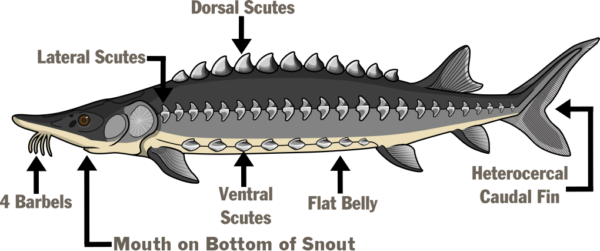

Illustrations by ©Makayla Haggard – DWR
Distribution
The Atlantic Sturgeon is native to all of Virginia’s major river systems that drain into the Chesapeake Bay, Atlantic Ocean, and Albemarle Sound.
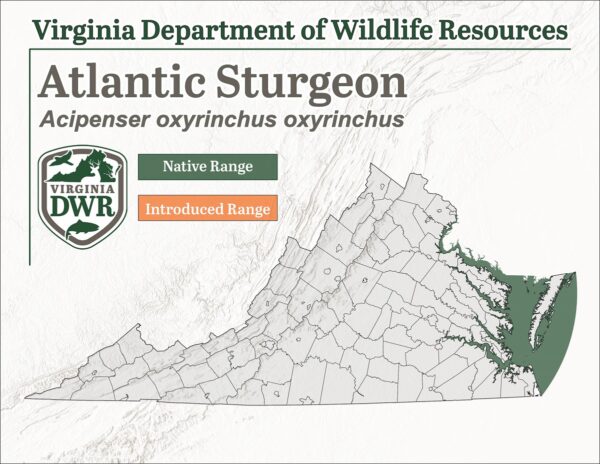
Habitat
Physical Habitat
The Atlantic Sturgeon spends most of its adult life along the continental shelf of the Atlantic Ocean. As an individual matures and begins its reproductive cycle, it leaves the marine environment and returns to the natal freshwater tributary in order to spawn. This is known as an anadromous reproductive strategy. Within many of Virginia’s waters, two distinct spawning migrations have been identified – with Atlantic Sturgeon ascending the larger Chesapeake Bay tributaries in either the spring or fall. As an Atlantic Sturgeon makes this upstream journey it seeks out the same rocky river bottoms from which it was born, in areas that are relatively clean of silt and other debris. Such zones allow for successful reproduction in which their adhesive eggs (up to 2 million of them) are able to stick to the substrate and receive adequate oxygenation during the incubation period. Upon hatching, juvenile Atlantic Sturgeon remain in their freshwater environments for several years before moving down to brackish estuaries and ultimately into the Atlantic Ocean as young adults.

A juvenile Atlantic Sturgeon captured during a trawl survey on the James River. ©VCU Rice Rivers Center
Water Quality
Atlantic Sturgeon require unimpaired waters with seasonally stable water temperatures in order to thrive. Juvenile Atlantic Sturgeon have been found to prefer river temperatures in the upper 60 degrees Fahrenheit. If such parameters aren’t met juvenile Atlantic Sturgeon must focus on relocating to better habitats rather than feeding and growing. Further, sexually mature Atlantic Sturgeon cue the timing of their spawning migration based primarily on water temperatures. As our climate continues to change, we can expect water temperature to play an increasingly important role in the health of Atlantic Sturgeon populations.
Diet
The sucker-like mouth of the Atlantic Sturgeon is positioned on the bottom of the snout and functions much like a vacuum. The mouth can protrude a considerable distance from the snout when fully extended. As this physiological adaptation may imply, Atlantic Sturgeon are primarily bottom feeders. Larval specimens possess tiny teeth which allows them to shred zooplankton in this early life stage.

A young-of-year Atlantic Sturgeon being measured during a sampling event. Photo by VCU Rice Rivers Center
As individuals grow into fingerlings and juveniles the teeth are lost and individuals transition into a diet comprised of worms and other small bottom-dwelling (benthic) organisms. Atlantic Sturgeon are equipped with barbels that function as taste buds and electroreceptors on their snout known as ampullae of Lorenzini that aids them in detecting other living creatures. This combination of sensory organs gives the Atlantic Sturgeon the ability to thrive in the benthic zone, where it opportunistically feeds upon insects, crustaceans, shrimp, mollusks, and other fish inhabiting the substrates.
Threats to Atlantic Sturgeon
Historical Overharvest and Habitat Loss
Before European colonization, Atlantic sturgeon populations were much more robust than they are now. The caviar fishery of the 19th century reduced populations of this long-lived species to a fraction of their former abundance, and since spawning females were targeted, that left few individuals to replenish the stocks. Sturgeon don’t reach maturity to reproduce until they are ten years or older, so in a short time, Atlantic sturgeon were on the brink of collapse. During this time, forests were being cleared and the Industrial Revolution introduced massive amounts of pollution to the Commonwealth’s air and waters. Sturgeon require clean, flowing water over solid substrate to spawn and the siltation resulting from landing clearing renders spawning habitat unusable. Many rivers were dammed and altered to facilitate shipping goods and to power mills with little thought to the impacts this has on migrating fish returning to their historical spawning habitat. Atlantic sturgeon were thought to be extirpated from many of Virginia’s tidal rivers due to overfishing, habitat loss, and pollution.
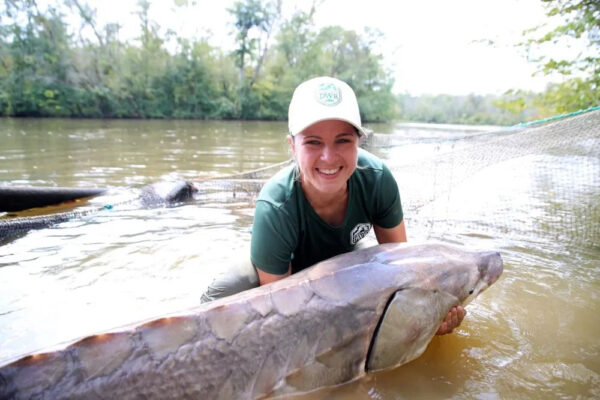
Virginia Tidal Rivers Project Leader Margi Whitmore assists agency partners in capturing and monitoring efforts. Photo by NOAA Fisheries
Recognizing that an intervention was needed, Virginia banned fishing for sturgeon in 1974 after decades of declining catches. The Atlantic States Marine Fisheries Commission formalized a Fishery Management Plan for sturgeon in 1990 that provided benchmarks for rebuilding the populations. Along with directed efforts to protect sturgeon, we realized the need to reduce pollution and restore habitats for wildlife. The Clean Water Act of 1972 helped restore water quality nationwide. Taking this a step further, the Commonwealth enacted the Chesapeake Bay Preservation Act of 1988 to protect and improve water quality in the Chesapeake Bay through effective land use management practices. The final act for Atlantic Sturgeon was their listing as Federally Endangered in 2012, which provides stringent protections for their populations and habitats.
Conservation Efforts in Virginia
The Virginia Department of Wildlife Resources takes an active role in helping sustain and improve upon populations of Atlantic Sturgeon throughout the Commonwealth. Virginia DWR accomplishes this by working diligently with sister agencies, Tribal Nations, nonprofit organizations, and local municipalities to help study and remediate several issues that are adversely impacting Atlantic Sturgeon.
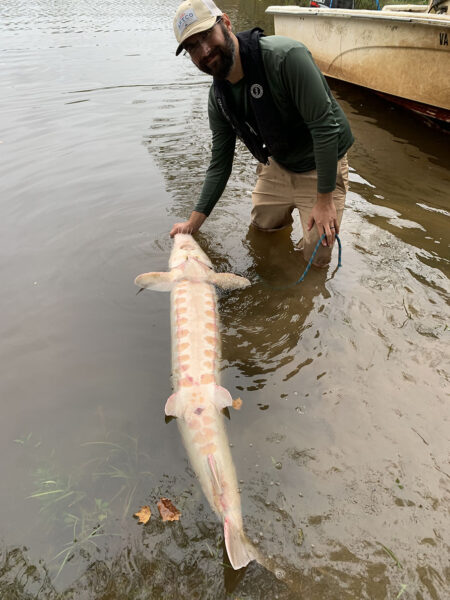
Regional Aquatics Manager Clint Morgeson assists partners with Atlantic Sturgeon sampling
In addition to assisting with the monitoring and evaluation of Atlantic Sturgeon population dynamics, the Virginia DWR provides protections to the species through science-based regulation and consultation services. The agency also actively seeks out land acquisition projects with the goal of implementing beneficial land stewardship practices which result in improved water quality parameters across the watershed. In many cases, anadromous species of fish have been cut off from reaching their historical inland habitats, and DWR attacks this issue head-on by identifying and removing or modifying fish passage barriers such as dams, culverts, and roads.

Virginia Fish Passage Coordinator Alan Weaver stands with agency partners at the recent South Anna – Ashland Mill Dam removal project located in the upper York Watershed.
Special Considerations
It is illegal to target Atlantic Sturgeon by angling. The Atlantic Sturgeon is listed as an endangered species under federal and Virginia law. It is a violation of state and federal law to harass, harm, or take any Atlantic Sturgeon.
For the definitions of take, harass, and harm, see 4 VAC 15-20-140.
Explore other stories and learn how Virginia DWR aids in the protection and recovery of threatened and endangered species in Virginia by visiting the Endangered Species Act Webpage!

Additional Information
Ghosts No More! How a coordinated approach has helped Atlantic sturgeon rebound in Virginia’s waters.
Read HERE
The Endangered Species Act Has Helped Bring the Atlantic Sturgeon Back to Virginia.
Read HERE
Report a Sturgeon Carcass
Ship-Strike Related Mortality
One emerging threat that concerns Atlantic Sturgeon researchers is the number of ship-strike mortalities observed within Virginia waters. Researchers are currently investigating the frequency of these encounters by collecting data from prop-strike mortality instances.
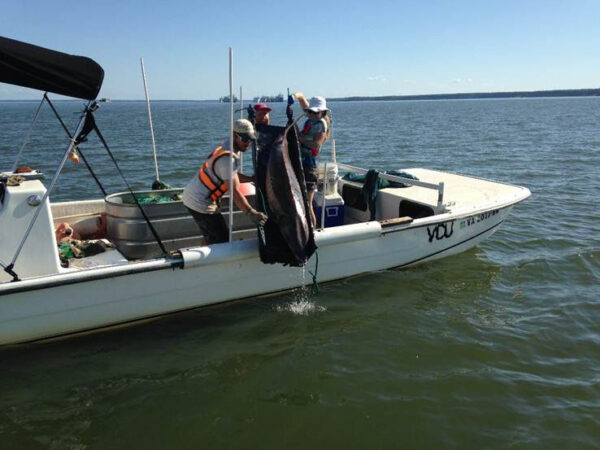
Dr. Matt Balazik, a research scientist for the VCU Rice Rivers Center and the Army Corps of Engineers, and his crew release an adult Atlantic Sturgeon after collecting biological information. Dr. Balazik bases his operations out of the VCU Rice Rivers Center, which is strategically located on the James River downstream of Richmond. Balazik’s research specializes in assessing Atlantic Sturgeon population dynamics and movement within the large tidal systems of the east coast.
If you come across a carcass or a stranded or injured Atlantic Sturgeon carcass, please report the encounter to one of the following Atlantic Sturgeon Salvage Partners:
Virginia Commonwealth University / U.S. Army Corps
Matthew Balazik (804)827-5800
balazikmt@vcu.edu
or
Chesapeake Scientific
Christian Hager (804)824-4530
christian.hager@chesapeakescientific.org
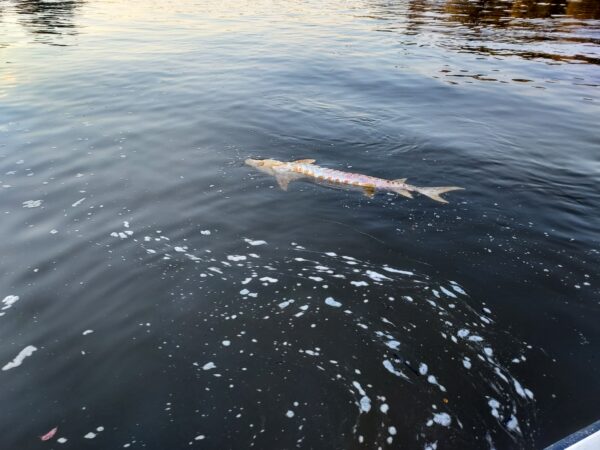
A large Atlantic Sturgeon carcass
Last updated: March 20, 2025
The Virginia Department of Wildlife Resources Species Profile Database serves as a repository of information for Virginia’s fish and wildlife species. The database is managed and curated by the Wildlife Information and Environmental Services (WIES) program. Species profile data, distribution information, and photography is generated by the Virginia Department of Wildlife Resources, State and Federal agencies, Collection Permittees, and other trusted partners. This product is not suitable for legal, engineering, or surveying use. The Virginia Department of Wildlife Resources does not accept responsibility for any missing data, inaccuracies, or other errors which may exist. In accordance with the terms of service for this product, you agree to this disclaimer.

